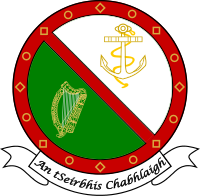21 June 2018
By Elaine Murphy
elaine@TheCork.ie
The Minister with responsibility for Defence, Mr. Paul Kehoe visited Babcock Marine’s Appledore Shipbuilding Yard in Devon, United Kingdom to witness first hand the continued progress on the build of the fourth new OPV for the Irish Naval Service.
The visit came as 11 members of the 56th Naval Cadet Class are due to be commissioned at the Irish Naval Base in Haulbowline on Friday (June 22).
The Minister was accompanied by Commodore Michael Malone, Flag Officer Commanding Naval Service and a senior representative from the Department of Defence.
The build of the 4th Offshore Patrol Vessel (OPV) to be named LÉ George Bernard Shaw is progressing well. The ship is alongside Newquay Dock, Appledore where the outfitting of the ship is taking place in conjunction with the process of running up and testing all the ships systems. The ship is scheduled to undergo Builders Sea Trials followed by Owners Sea Acceptance Trials (SATs) in July 2018. The delivery date of the ship will be confirmed on the successful completion of the SATs. The ship is to be fitted with a 76mm Naval Compact Gun later this year in the Naval Base, Haulbowline, County Cork. The ship when completed will be formally named and commissioned into the Irish Naval Service later this year.
Minister Kehoe said:
“I want to acknowledge the relationship between the Defence organisation and Babcock which has already seen five of the current in-service Irish Naval Service vessels built in the Appledore facility together with the ongoing build which will see a sixth ship delivered in the very near future”.
He complimented Babcock “for their ability to produce very well designed and stylish ships with state of the art equipment which have already proven their value to the Naval Service both at home and on overseas missions.
Minister Kehoe said that “he looked forward to the completion of the ship and Sea Acceptance Trials in July 2018 and the ships addition to the Naval Service fleet where it will be a key driver in the essential provision of defence capability in the maritime domain around our country.”
Factbox
LÉ Roisin and LÉ Niamh were the first two ships built in the Appledore facility over sixteen years ago – both ships remain key elements of the Irish Naval Service fleet.
The current Naval Service ship replacement programme has seen the replacement of three Naval Service vessels with a fourth new vessel scheduled for delivery shortly.
Three ships, LÉ Samuel Beckett (named and commissioned May 2014), LÉ James Joyce (named and commissioned September 2015) and LÉ William Butler Yeats (named and commissioned in October 2016) have been delivered and are in full operational service. The value of the three-ship contract was €199.4m, inclusive of VAT.
In June 2016 agreement was reached with Babcock International for the provision for an additional ship for the Naval Service to be built in their facility in Appledore, Devon. The ship will be the same class as LÉ Samuel Beckett, LÉ James Joyce and LÉ William Butler Yeats and is to be named LÉ George Bernard Shaw.
The agreed contract value for the further ship is €67m inclusive of VAT and delivery is expected in July 2018. This aligns with the project planning process in place under the White Paper on Defence which will determine the Defence Organisation’s maritime capability requirements.
The requirement for a fourth ship is regarded as urgent and expedient given the age of several of the ships in the fleet, including LÉ Orla, LÉ Ciara and LÉ Eithne, all of which are well over thirty years of age. The additional ship will allow the Naval Service meet its patrol day targets with due cognisance to the significant operational requirements for the Naval fleet on overseas operations.
The White Paper on Defence provides for the replacement of the current flagship, LÉ Eithne, by a multi-role vessel (MRV). LÉ Eithne was built in 1984. Planning has commenced on this project and it is intended to hold a public tender competition in due course to cover the supply of the MRV. Future maritime capability requirements are being considered as part of the White Paper planning process.


